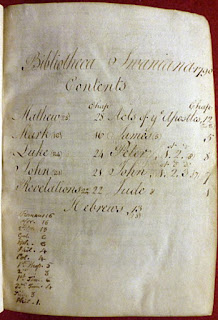[Continued from the previous post]
Before turning to its origin, what is known about the later provenances of the Duke and NYPL volumes? In brief, they are as follows:
NYPL, MS MA 134
- David Swan (who remains unidentified): inscribed "Bibliotheca Swaniana, 1790", with his characteristic pagination and table of contents.
- Wilfred M. Voynich (1865-1930); with a clipping stuck to the front endpapers, presumably from one of his catalogues, the description ending "(439)": the pastedown also inscribed in pencil "439 / $650": acquired from him in 1925 by:
- Wilberforce Eames (1855-1937), of Brooklyn, NY, Bibliographer of the New York Public Library (de Ricci, Census, 1937, p. 2314 no. 10); bequeathed by him in 1940 to:
- The New York Public Library (Bond & Faye, 1962, p. 329 no. 134)
Duke University, Latin MS 32
- Unidentified 16th-century English owner: inscribed with note on Calvin's sacramental doctrine (f.10v)
- Unidentified 19th-century English owner: inscribed with a transcription of the Calvin note (f.11r)
- "Bound by / Lewis & Sons, / Gough Square / Fleet St. London.", according to their printed label:
- Alan G. Thomas, with his pencil price "£350" and price-code "UUX/-/" (i.e. £220) on the verso of the first flyleaf his Catalogue 15 (1964), no. 5: bought in January 1965 by:
- Duke University, NC.
Unlike most calendars, which allow a single line for each day of the year, this one often allows several lines of text to a single day, in order to include daily liturgical information such as the incipits of collects, antiphons, and versicles. Gradings are up to 12 lections, indicating monastic Use. Each month continues from the preceding one without starting a new page:
Almost all feasts are in plain brown ink, with red reserved for the liturgical rubrics and for a few of the most important feasts of Christ and the Virgin and and a very few others (Epiphany, Annunciation, John the Baptist, etc.). The only exception to the plain colour-scheme is that two feasts of the Virgin -- the Nativity and Assumption -- are in gold:
Among the plain brown feasts are several Cistercian ones (Bernard, Robert, Malachi, Edmund, et al.), and at 6 June is the "Dedicatio basilice sancte marie de valle", with 12 lections "xii. l.'":
presumably referring to the Cistercian abbey of Notre-Dame du Val (whose ruins are shown at the top of this post), in the Ile-de-France, north of Paris.
As the calendar is Cistercian, it can be dated with some precision, to between 1247 and 1255. Because St Edmund of Abingdon is included (d.1240, canonized 1246, added to the Cistercian calendar 1247) (16 Nov.), it must date after 1247, and because Dominic (d.1221, canonized 1234, added to the Cistercian calendar 1255) and Peter Martyr (died 1252, canonized 1253, added to the Cistercian calendar 1255) (30 April) are absent, it probably dates before 1255.















No comments:
Post a Comment
** PLEASE INCLUDE YOUR NAME IN YOUR COMMENT **
I may ignore and delete anonymous comments